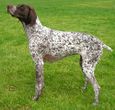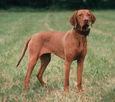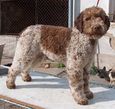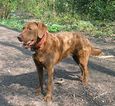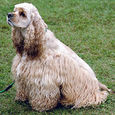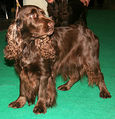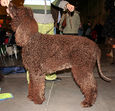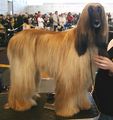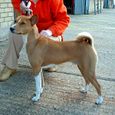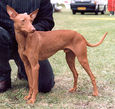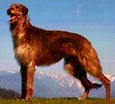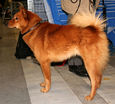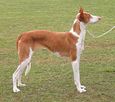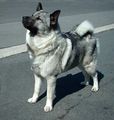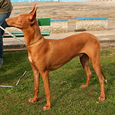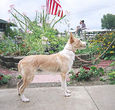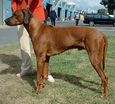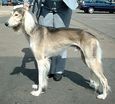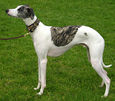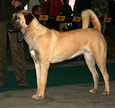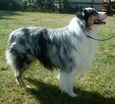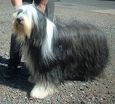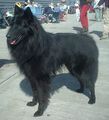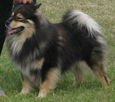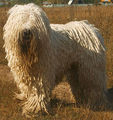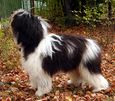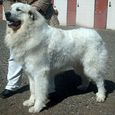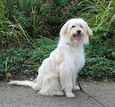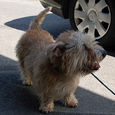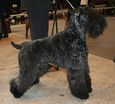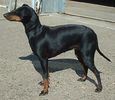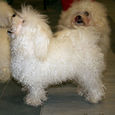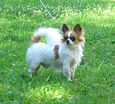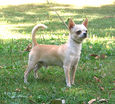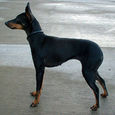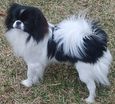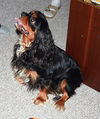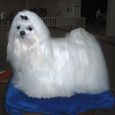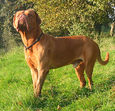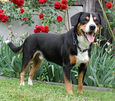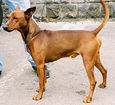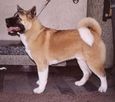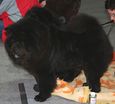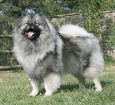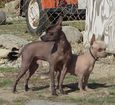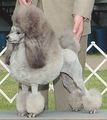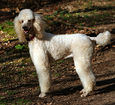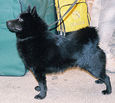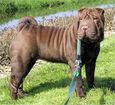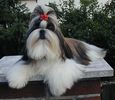|
|
| Línea 52: |
Línea 52: |
| | | | |
| | ===Hound Group=== | | ===Hound Group=== |
| − | *Traditionally used for hunting by scent or sight. They require a significant amount of exercise and can be described as dignified, aloof but trustworthy companions.^ | + | *Tradicionalmente utilizado para la caza por el olfato o la vista. Ellos requieren una cantidad considerable de ejercicio y puede ser descrito como compañeros dignos, al margen pero confiables.^ |
| | <gallery widths="115px" perrow="5"> | | <gallery widths="115px" perrow="5"> |
| | Image:Afghan Hound.jpg|'''Afgano'''<p><small>( © Zwoenitzer WikiMedia Commons)</small> | | Image:Afghan Hound.jpg|'''Afgano'''<p><small>( © Zwoenitzer WikiMedia Commons)</small> |
Revisión del 17:43 27 jul 2011
Introducción
Las siguientes razas se han clasificado de acuerdo a las directrices del Kennel Club. Cualquier raza que no forman parte de estas directrices, se ha omitido, con exclusión de la sección de perros peligrosos. Las descripciones de cada grupo son también del Kennel Club. Para más información sobre una raza específica, por favor ver http://www.thekennelclub.org.uk/.
Perros de Caza
- Los perros que fueron entrenados originalmente para encontrar la caza en vivo y/o para recuperar la caza que había sido disparado. Este grupo se divide en cuatro categorías - Retriever, Perros de agua, Caza/Pointer/Recuperar y Setters.^
Braco Italiano( © Gábor Essösy WikiMedia Commons)
Brittany( © JL Goasdoue WikiMedia Commons)
Setter Inglés( © Ellen Levy Finch WikiMedia Commons)
Pointer Alemán de Pelo Largo( © Pleple2000 WikiMedia Commons)
Pointer Alemán de Pelo Corto( © Ellen Levy Finch WikiMedia Commons)
Braco Alemán de Pelo Duro( © Ellen Levy Finch WikiMedia Commons)
Setter Gordon( © Jukka Puro WikiMedia Commons)
Vizsla( © Tino Hentschel WikiMedia Commons)
Vizsla de Pelo Duro( © Pleple2000 WikiMedia Commons)
Setter Irlandés Rojo y Blanco( © Pleple2000 WikiMedia Commons)
Setter Irlandés( © Luis Miguel Bugallo Sánchez WikiMedia Commons)
Spinone Italiano( © Alephalpha WikiMedia Commons)
Kooikerhondje( © Caronna WikiMedia Commons)
Korthals Griffon( © Ellen Levy Finch WikiMedia Commons)
Lagotto Romagnolo( © Caronna WikiMedia Commons)
Münsterländer Grande( © Caronna WikiMedia Commons)
Pointer( © Fir0002 WikiMedia Commons)
Retriever de La Bahía de Chesapeake( © Nevilley WikiMedia Commons)
Retriever (Pelo Rizado)( © Zwoenitzer WikiMedia Commons)
Retriever (Pelo Liso)( © Gunnandreassen WikiMedia Commons)
Retriever (Golden)( © Monika Mężyńska WikiMedia Commons)
Retriever (Labrador)( © Ellen Levy Finch WikiMedia Commons)
Retriever (Nova Scotia Duck Tolling)( © Malgorzata Korbel WikiMedia Commons)
Slovakian Rough Haired Pointer( © Pleple2000 WikiMedia Commons)
Münsterländer Pequeño( © F. Wiertz WikiMedia Commons)
Cocker Americano( © Ellen Levy Finch WikiMedia Commons)
Spaniel (American Water)( © Awsguy1 WikiMedia Commons)
Clumber Spaniel( © Pleple2000 WikiMedia Commons)
Spaniel (Cocker Inglés)( © Ellen Levy Finch WikiMedia Commons)
Spaniel (Field)( © Pleple2000 WikiMedia Commons)
Spaniel de Agua Irlandés( © Pleple2000 WikiMedia Commons)
Spaniel (Sussex)( © Pleple2000 WikiMedia Commons)
Springer Spaniel Galés( © Lokal_Profil WikiMedia Commons)
Perro De Agua Español( © Przykuta WikiMedia Commons)
Weimaraner( © Ellen Levy Finch WikiMedia Commons)
Hound Group
- Tradicionalmente utilizado para la caza por el olfato o la vista. Ellos requieren una cantidad considerable de ejercicio y puede ser descrito como compañeros dignos, al margen pero confiables.^
Afgano( © Zwoenitzer WikiMedia Commons)
Basenji( © ToB WikiMedia Commons)
Basset Azul de Gascuña( © Caronna WikiMedia Commons)
Basset Leonado de Bretaña( © sannse WikiMedia Commons)
Basset Griffon Vendeen (Grande)( © sannse WikiMedia Commons)
Basset Griffon Vendeen (Pequeño)( © sannse WikiMedia Commons)
Bassethound( © Cwazi WikiMedia Commons)
Rastreador montañes de Baviera( © Sicherlich WikiMedia Commons)
Beagle( © sannse WikiMedia Commons)
Bloodhound( © GDK WikiMedia Commons)
Borzoi (Galgo Ruso)( © Pleple2000 WikiMedia Commons)
Cirneco Del Etna( © Pleple2000 WikiMedia Commons)
Teckel (Miniatura)( © Ellen Levy Finch WikiMedia Commons)
Teckel (Pelo Corto)( © Bubastic WikiMedia Commons)
Deerhound( © Craig Pemberton WikiMedia Commons)
Spitz Finlandés( © Pleple2000 WikiMedia Commons)
Foxhound( © Luna04 WikiMedia Commons)
Grand Bleu De Gascogne( © RanchoRosco WikiMedia Commons)
Galgo( © ToB WikiMedia Commons)
Hamiltonstovare( © sannse WikiMedia Commons)
Podenco Ibicenco( © Pleple2000 WikiMedia Commons)
Wolfhound Irlandés( © Caronna WikiMedia Commons)
Elkhound Noruego( © sannse WikiMedia Commons)
Otterhound( © Machinecha WikiMedia Commons)
Pharaoh Hound( © Pleple2000 WikiMedia Commons)
Podenco Portugués( © Caronna WikiMedia Commons)
Ridgeback de Rodesia( © sannse WikiMedia Commons)
Saluki (Galgo Persa)( © sannse WikiMedia Commons)
Segugio Italiano( © Cyberjobe WikiMedia Commons)
Sloughi( © Dr. Sabine Schlenkrich WikiMedia Commons)
Whippet( © Ellen Levy Finch WikiMedia Commons)
Pastoral Group
- Herding dogs that are associated with working cattle, sheep, reindeer and other cloven footed animals. Usually this type of canine has a weatherproof double coat to protect it from the elements when working in severe conditions.^
Pastor de Anatolia( © Pleple2000 WikiMedia Commons)
Boyero Australiano( © Ellen Levy Finch WikiMedia Commons)
Pastor Australiano( © sannse WikiMedia Commons)
Collie Barbudo( © sannse WikiMedia Commons)
Pastor Belga (Groenendael)( © sannse WikiMedia Commons)
Pastor Belga (Laekenois)( © sannse WikiMedia Commons)
Pastor Belga (Malinois)( © Pharaoh Hound WikiMedia Commons)
Pastor Belga (Tervuren)( © sannse WikiMedia Commons)
Perro de Pastor Bergamasco( © Pleple2000 WikiMedia Commons)
Border Collie( © sannse WikiMedia Commons)
Briard( © Caronna WikiMedia Commons)
Pastor Catalán( © Caronna WikiMedia Commons)
Collie( © sannse WikiMedia Commons)
Collie Smooth( © Pleple2000 WikiMedia Commons)
Perro de Montaña de la Sierra de la Estrela( © Bot WikiMedia Commons)
Finnish Lapphund( © ApDevries WikiMedia Commons)
Pastor Alemán (Alsatian)( © Ellen Levy Finch WikiMedia Commons)
Hungarian Kuvasz( © Szora WikiMedia Commons)
Puli( © Puli1989 WikiMedia Commons)
Komondor( © Nikki68 WikiMedia Commons)
Lancashire Heeler( © sannse WikiMedia Commons)
Perro Pastor Maremmano-Abruzzese( © Caronna WikiMedia Commons)
Norwegian Buhund( © Solkol WikiMedia Commons)
Old English Sheepdog( © PardoY WikiMedia Commons)
Pastor Polaco de Tierras Bajas
Perro de Montaña de Los Pirineos( © sannse WikiMedia Commons)
Pastor de Los Pirineos( © Gflaccav2 WikiMedia Commons)
Samoyed( © Joonasl WikiMedia Commons)
Pastor de Shetland( © Ellen Levy Finch WikiMedia Commons)
Lapphund Sueco( © Bhrl WikiMedia Commons)
Valhund Sueco( © Florent Laffineur WikiMedia Commons)
Corgi Galés Cárdigan( © Kubek15 WikiMedia Commons)
Corgi Galés Pembroke( © sannse WikiMedia Commons)
Terrier Group
- Dogs originally bred and used for hunting vermin. This hardy collection of dogs were selectively bred to be extremely brave and tough, and to pursue fox, badger, rat and otter (to name but a few) above and below ground.^
Terrier de Airedale( © Pleple2000 WikiMedia Commons)
Terrier Australiano( © Lilly M WikiMedia Commons)
Bedlington Terrier( © Pleple2000 WikiMedia Commons)
Border Terrier( © Charlesjsharp WikiMedia Commons)
Bull Terrier( © Meghaduta WikiMedia Commons)
Bull Terrier (Miniatura) (Right)( © Pleple2000 WikiMedia Commons)
Cairn Terrier( © Poesje87 WikiMedia Commons)
Terrier Cesky( © Pleple2000 WikiMedia Commons)
Dandie Dinmont Terrier( © sannse WikiMedia Commons)
Fox Terrier (Pelo Liso)( © Alephalpha WikiMedia Commons)
Fox Terrier (Pelo Duro)( © Pharaoh Hound WikiMedia Commons)
Glen Of Imaal Terrier( © Scoo WikiMedia Commons)
Terrier Irlandés( © Anne Sollerud WikiMedia Commons)
Kerry Blue Terrier( © Pleple2000 WikiMedia Commons)
Lakeland Terrier( © sannse WikiMedia Commons)
Terrier de Manchester( © sannse WikiMedia Commons)
Terrier de Norfolk( © Arschimedes WikiMedia Commons)
Terrier de Norwich( © Pleple2000 WikiMedia Commons)
Parson Russell Terrier( © JRTfan WikiMedia Commons)
Terrier Escocés( © Svencb WikiMedia Commons)
Sealyham Terrier( © Pleple2000 WikiMedia Commons)
'
Terrier de Skye( © Pleple2000 WikiMedia Commons)
Soft Coated Wheaten Terrier( © Pleple2000 WikiMedia Commons)
Staffordshire Bull Terrier( © Pleple2000 WikiMedia Commons)
Terrier Galés( © ShawmutSteve WikiMedia Commons)
West Highland( © Pharaoh Hound WikiMedia Commons)
Toy Group
- Small companion or lap dogs. Many of the Toy breeds were bred for this capacity although some have been placed into this category due to their size. They should have friendly personalities and love attention. They do not need a large amount of exercise and some can be finicky eaters.^
Affenpinscher( © sannse WikiMedia Commons)
Terrier Australiano( © Caronna WikiMedia Commons)
Bichón Frisé( © sannse WikiMedia Commons)
Bichón Boloñés( © Pleple2000 WikiMedia Commons)
Cavalier King Charles( © Pleple2000 WikiMedia Commons)
Chihuahua (Pelo Largo)( © Maram WikiMedia Commons)
Chihuahua (Pelo Liso)( © Maram WikiMedia Commons)
Chinese Crested( © BetacommandBot WikiMedia Commons)
Coton de Tular( © Caronna WikiMedia Commons)
English Toy Terrier( © sannse WikiMedia Commons)
Grifón de Bruselas( © Lilly M WikiMedia Commons)
Havanese( © Ltshears WikiMedia Commons)
Galgo Italiano( © Miyagawa WikiMedia Commons)
'
Chin Japonés( © Alandennis WikiMedia Commons)
King Charles Spaniel( © Karelj WikiMedia Commons)
Lowchen( © Ainos WikiMedia Commons)
Maltese( © sannse WikiMedia Commons)
Pinscher Miniatura( © Myminpins WikiMedia Commons)
Papillon( © Gvdmoort WikiMedia Commons)
Pequinés( © Lilly M WikiMedia Commons)
Pomerania( © Willc2 WikiMedia Commons)
Pug( © sannse WikiMedia Commons)
Yorkshire Terrier( © Jlcerso WikiMedia Commons)
Working Group
- Over the centuries these dogs were selectively bred to become guards and search and rescue dogs. Arguably, the working group consists of some of the most heroic canines in the world, aiding humans in many walks of like, including the Boxer, Great Dane and St. Bernard.^
Malamute de Alaska( © SCMW WikiMedia Commons)
Beauceron( © Pleple2000 WikiMedia Commons)
Perro de Montaña Bernés( © Caronna WikiMedia Commons)
Boyero de Flandes( © ToB WikiMedia Commons)
Bóxer( © Lilly M WikiMedia Commons)
Mastín( © Pleple2000 WikiMedia Commons)
Perro Esquimal Canadiense( © Exhaustfumes WikiMedia Commons)
Doberman( © John Adams WikiMedia Commons)
Dogo de Burdeos( © StBrecht WikiMedia Commons)
Perro de Montaña Appenzell( © Serge Renggli WikiMedia Commons)
Pinscher Alemán( © Pleple2000 WikiMedia Commons)
Schnauzer Gigante( © Bohemianroots WikiMedia Commons)
Gran Danés( © Lilly M WikiMedia Commons)
Perro de Montaña Gran Suizo( © KIKKUZZO88 WikiMedia Commons)
Greenland Dog( © Thegreenj WikiMedia Commons)
Hovawart( © Faigl.ladislav WikiMedia Commons)
Leonberger( © Pleple2000 WikiMedia Commons)
Mastín Inglés( © Radovan Rohovsky WikiMedia Commons)
Mastín Napolitano( © Lisa M. Herndon WikiMedia Commons)
Newfoundland( © SKern WikiMedia Commons)
Perro de Aguas Portugués( © Caronna WikiMedia Commons)
Mastín de los Pirineos( © ToB WikiMedia Commons)
Rottweiler( © Caronna WikiMedia Commons)
Terrier Ruso Negro( © Caronna WikiMedia Commons)
San Bernardo( © Eversontum WikiMedia Commons)
Husky Siberiano( © Utopialand WikiMedia Commons)
'
Mastín Tibetano( © Pleple2000 WikiMedia Commons)
Utility Group
- The name "Utility" basically means fitness for a purpose and this group consists of an extremely mixed and varied bunch, most breeds having been selectively bred to perform a specific function not included in the sporting and working categories.^
Akita( © Pleple2000 WikiMedia Commons)
Boston Terrier( © Ellen Levy Finch WikiMedia Commons)
Bulldog( © Makemi WikiMedia Commons)
Canaan Dog( © Matilda WikiMedia Commons)
Chow Chow( © Pleple2000 WikiMedia Commons)
Dálmata( © Miroslav Cacik WikiMedia Commons)
Eurasier( © Ltshears WikiMedia Commons)
Bulldog Francés( © danny O WikiMedia Commons)
Spitz Alemán (Klien)( © Evlesa WikiMedia Commons)
Spitz Alemán (Mittal)( © PJLHowell WikiMedia Commons)
Akita Japonés( © Yozakura WikiMedia Commons)
Shiba Japonés( © Yozakura WikiMedia Commons)
Spitz Japonés( © Ssmats WikiMedia Commons)
Keeshond( © Pharaoh Hound WikiMedia Commons)
Korean Jindo( © ToB WikiMedia Commons)
Lhasa Apso( © Elminjas WikiMedia Commons)
Perro Sin Pelo Mexicano (Estandard/Miniatura)( © Maikemo WikiMedia Commons)
Schnauzer Miniatura( © MagnusK WikiMedia Commons)
Caniche (o Poodle) Miniatura( © Berlinda WikiMedia Commons)
Caniche (o Poodle) Estandard( © John Leslie WikiMedia Commons)
Caniche (o Poodle) Toy( © Manuel González Olaechea y Franco WikiMedia Commons)
Schipperke( © Pleple2000 WikiMedia Commons)
Schnauzer (Estandard)( © Madwren WikiMedia Commons)
Shar Pei( © Wrinkle WikiMedia Commons)
Shih Tzu( © Caronna WikiMedia Commons)
Spaniel Tibetano( © Wolfman1 WikiMedia Commons)
Terrier Tibetano( © Pudeo WikiMedia Commons)
Dangerous Dogs Act 1991
- It is an offence to own or keep any of the types of dog listed below, unless it is on the Index of Exempted Dogs and is in compliance with the requirements. In any event it is an offence to breed from, sell or exchange (even as a gift) such a dog, irrespective of whether it has been placed on the Index of Exempted Dogs. See http://www.defra.gov.uk/animalh/welfare/domestic/dogs.htm
Pit Bull AmericanoTerrier( © Marthy WikiMedia Commons)
Tosa Inu (Japonés)( © Pleple2000 WikiMedia Commons)
Dogo Argentino( © Christian PInatel WikiMedia Commons)
Fila Brasileiro( © Cittanuvo WikiMedia Commons)
References:
- Breed Group Listings (2006), The Kennel Club, London
- Dangerous Dogs Act 1991, Department for Environmental, Food and Rural Affairs




